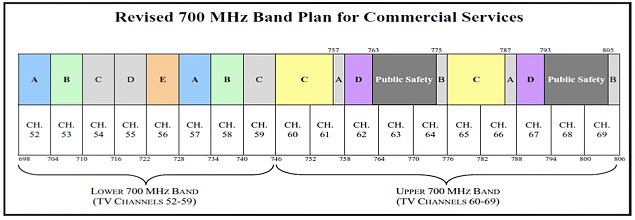Cellphone, DTV Interference Issues Examined
You probably heard that in August the FCC acted on a petition by CTIA-The Wireless Association that it not grant any more licenses for Channel 51 because of interference to cellphones.
I've heard this petition by the CTIA was due to a paper study of the problem, and not due to actual cases of harmful interference by DTV signals to cell phones operating in the 700 MHz Band.
THE REVISED PLAN
There are about 30 stations on Channel 51 in the United States. The revised 700 MHz Band Plan for Commercial Services is shown in Fig. 1. Block A 698–704 MHz shown in blue was formerly Channel 52.
Suppose there is a full-power DTV station on Channel 51. Its authorized power would be up to 1000 kW. Sideband splatter into adjacent channels 50 and 52 is limited by the FCC RF mask filter.
By integrating the area under the mask from 692 to 698 MHz or from 704 to 710 MHz, the noise power allowed in what was Channel 52 is 44.71 dB below the DTV power being radiated in Channel 51. 1000 kW is 30 dB above 1 kW or 30 dBK. Subtracting 44.75 dB from +30 dBK, we get –17.71 dBK or 33.8 W of noise power in Block A.
There would be no noise in other blocks from a DTV signal on Channel 51. This is well known from IEEE papers published in IEEE Transactions by Dr. Oded Bendov (March, 2005) and others.

Fig. 1: Revised 700 MHz Band Plan for Commercial Services For a cell phone tuned to Block A, this 33.8 W is co-channel noise. This radiated noise power is comparable to the signal power radiated by base stations. Noise is an effective jamming signal as it fills the block uniformly.
Now let us fast forward to that day when Channel 31 no longer carries DTV signals, but cell phone traffic. Won't the problem cited by the CTIA re-appear?
So what should the FCC do about Channel 30? If it adopts the same approach as it has implemented for Channel 51, Channel 30 will not be licensed to broadcasters.
Perhaps the compromise is drawn at Channel 37. This means cell phones would operate on Channel 38 and above, while broadcasters would operate on Channel 36 and below. But this would fall short of the FCC National Broadband Plan to take 120 MHz from TV.
And, I don't think it would solve the range of interference issues that have surfaced.
JUST SUPPOSE…
Many readers will still remember my writing about interference due to DTV signals on certain pairs of channels of the form (N+K) and (N+2K). K is an integer, positive or negative. For example let K = 3. Third-order IM products will be generated by signals on Channels 32 and 38, which fall in Channels 28, 29, and 30, and 37, 38 and 39 as shown in Fig. 2.
Suppose channel 38 is auctioned and the owner is a cell phone operator. He might think that, with no broadcasters operating on Channel 37, he has a "clear channel." But as you see, there could be a lot of noise in Channel 38, which may be generated in cell phone receivers by overloading their "front end" with strong DTV signals on Channels 32 and 35.

Fig. 2: Two undesired signals on channels spaced three channels apart (K = 3) generate third-order IM products. The strongest are three channels below the lower signal and three channels above the higher frequency signal. These IM products are three channels wide. (See expanded figure with Rhodes’ column online.)
I cannot say that all cell phone receivers will be overloaded, but I can say that this is a problem for DTV receivers.
My point is that I expect that cell phones designed for the 700 MHz band will use tuners quite similar to those in DTV converter boxes and receivers so I expect similar vulnerability to interference.
In the December 2010 issue of IEEE Transactions on Broadcasting, Steve Martin described just this sort of effect, which he observed in the FCC Laboratory tests of NTIA-approved DTV converter boxes. He tested:
K = +/–2, 3, 5, and 10
D = –28 dBm, –53 dBm and –68 dBm
115 NTIA-approved DTV converter boxes
At D = –53 dBm, the maximum U signal power per channel at which the receivers were able to function was about –30 dBm for K = 3
At D = –68 dBm, the maximum U power per channel at which the receivers were able to function was about –22 dBm for K = 3
As Fig. 2 shows, the noise power peaks in Channels 29 and 38 and these peaks are equal. In Channels 28 and 30 and also Channels 37 and 39 there is less noise, but still, it might be enough near the edge of coverage to matter for rooftop antennas and much closer in for indoor antennas.
I plan to run tests on the 26 NTIA-approved converter boxes in my laboratory to fill in the gaps for untested values of K>1. It is impossible to test for K = 1 because that would require a complex filter to lower the noise in the undesired signals. I believe Martin did not test for K = 1 for this reason. When you look at differences in D/U for K = 2 and K = 10, they seem small, indicating the RF selectivity as far out as +/–60 MHz from the desired signal is not very impressive; 4 dB change in U powers for K from 2 to 10.
Charles Rhodes is a consultant in the field of television broadcast technologies and planning. He can be reached via e-mail at cwr@bootit.com.
The professional video industry's #1 source for news, trends and product and tech information. Sign up below.
